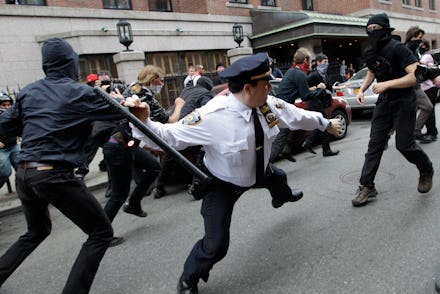Turns Out The Government Has Been Ignoring a Police Brutality Law for Nearly 20 Years

The news: If you've been frustrated by the media's inability to report hard statistics on police brutality, there's a good reason for that — there aren't any.
As the nation continues to focus on issues of race and police abuse in the wake of Michael Brown's shooting death in Missouri earlier this month, journalists have found themselves running up against a frustrating roadblock: the lack of verified, nationwide figures on police brutality.
The problem: In 1994, Congress passed a law instructing law enforcement agencies to regularly collect data on excessive police force. The U.S. Attorney General was charged with overseeing this, but the law was poorly enforced and agencies effectively stopped in 2001. Now we are scratching for statistics solely because the federal government was too lazy to keep up this important program.
As the International Business Times notes, the responsibility was passed off to various Department of Justice agencies, then to the International Association for Chiefs of Police (IACF), the National Institute for Justice and the Bureau of Justice Statistics. The IACP eventually produced a report on police brutality in 2001, but no one has followed up since.
Image Credit: AP
That means government statisticians have had to rely on Google News alerts and crowdsourced Wikipedia databases to receive up-to-date information on police brutality across the country. Unfortunately, these sources don't paint a complete picture and certainly don't provide the kind of comprehensive figures that law enforcement agencies need to properly regulate themselves.
"That's a clear, clear problem," Matthew Hickman, associate professor of criminal justice at Seattle University, told McClatchy. "When it comes to use of force, we have almost nothing."
Image Credit: AP
Holding the government accountable. Independent organizations such as FiveThirtyEight and Deadspin have attempted to pinpoint just how many instances of police brutality and homicide occur in the U.S. every year, but they, too, have admitted their limitations for a few reasons:
1. It's hard to regulate or verify self-reported data.
2. There are more than 17,000 law enforcement agencies in the United States, all with different standards of documenting police brutality.
3. There are probably numerous instances of police brutality that get swept under the rug before the media even hears of it.
There are also big discrepancies among the independently collected figures that do exist, making it hard for journalists and analysts to determine which one is accurate.
Whether it is due to bureaucratic oversight or deliberate obfuscation, the fact remains that right now, we don't even know how many people die at the hands of American law enforcement officers every year. Whatever the reason may be, now more than ever this law needs to be reprioritized.